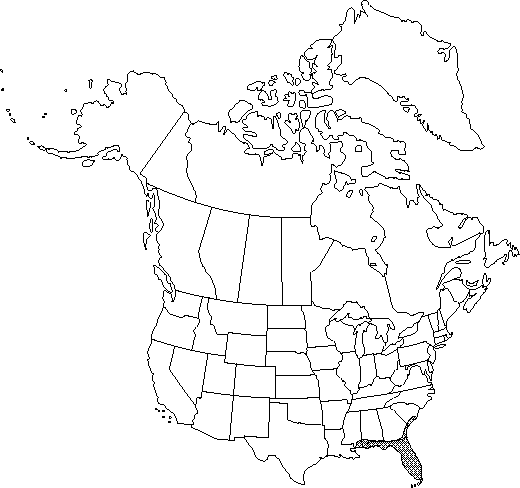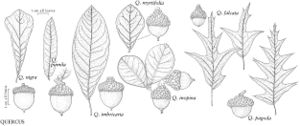Quercus myrtifolia
Sp. Pl. 4(1): 424. 1805.
Trees or shrubs, evergreen, to 12 m. Bark gray and smooth distally, dark and shallowly furrowed near base. Twigs dark red-brown, 1-2.5(-3) mm diam., persistently pubescent, rarely almost glabrous. Terminal buds reddish to purplish brown, ovoid, 2-5.5 mm, glabrous or with tuft of tawny hairs at apex. Leaves: petiole 1-5 mm, glabrous, occasionally sparsely pubescent. Leaf blade elliptic to narrowly or broadly obovate, occasionally spatulate, 15-50(-70) × 10-25(-35) mm, base cuneate to rounded, margins entire, somewhat revolute, with 1-4 awns, apex obtuse or rounded; surfaces abaxially glabrous except for axillary tufts of tomentum, occasionally yellow-scurfy, adaxial surface planar, glabrous. Acorns biennial; cup saucer-shaped to shallowly goblet-shaped, 4-7 mm high × 8.5-14.5 mm wide, covering 1/4-1/3 nut, outer surface puberulent, inner surface half to fully pubescent, scale tips tightly appressed, acute; nut broadly ovoid to globose, 9.5-14 × 8-13 mm, glabrate, scar diam. 5-8 mm.
Phenology: Flowering spring.
Habitat: Dunes, hammocks, sandhills, dry sandy ridges, and oak scrub
Elevation: 0-100 m
Distribution

Ala., Fla., Ga., Miss., S.C.
Discussion
This species flowers one to two weeks earlier than Q. inopina (A. F. Johnson and W. G. Abrahamson 1982).
Quercus myrtifolia reportedly hybridizes with Q. incana (= Q. ×oviedoensis Sargent), but E. J. Palmer (1948) questioned the identification of the type specimen; the brief description by Sargent suggests that the specimen may be from an individual of Q. inopina. D. M. Hunt (1989) cited evidence of hybridization with Q. arkansana, Q. hemisphaerica, Q. inopina, Q. laurifolia, Q. marilandica, Q. nigra, and Q. pumila (Hunt suggested that the last may give rise to occasional reports of annual fruiting in Q. myrtifolia).
Selected References
None.
